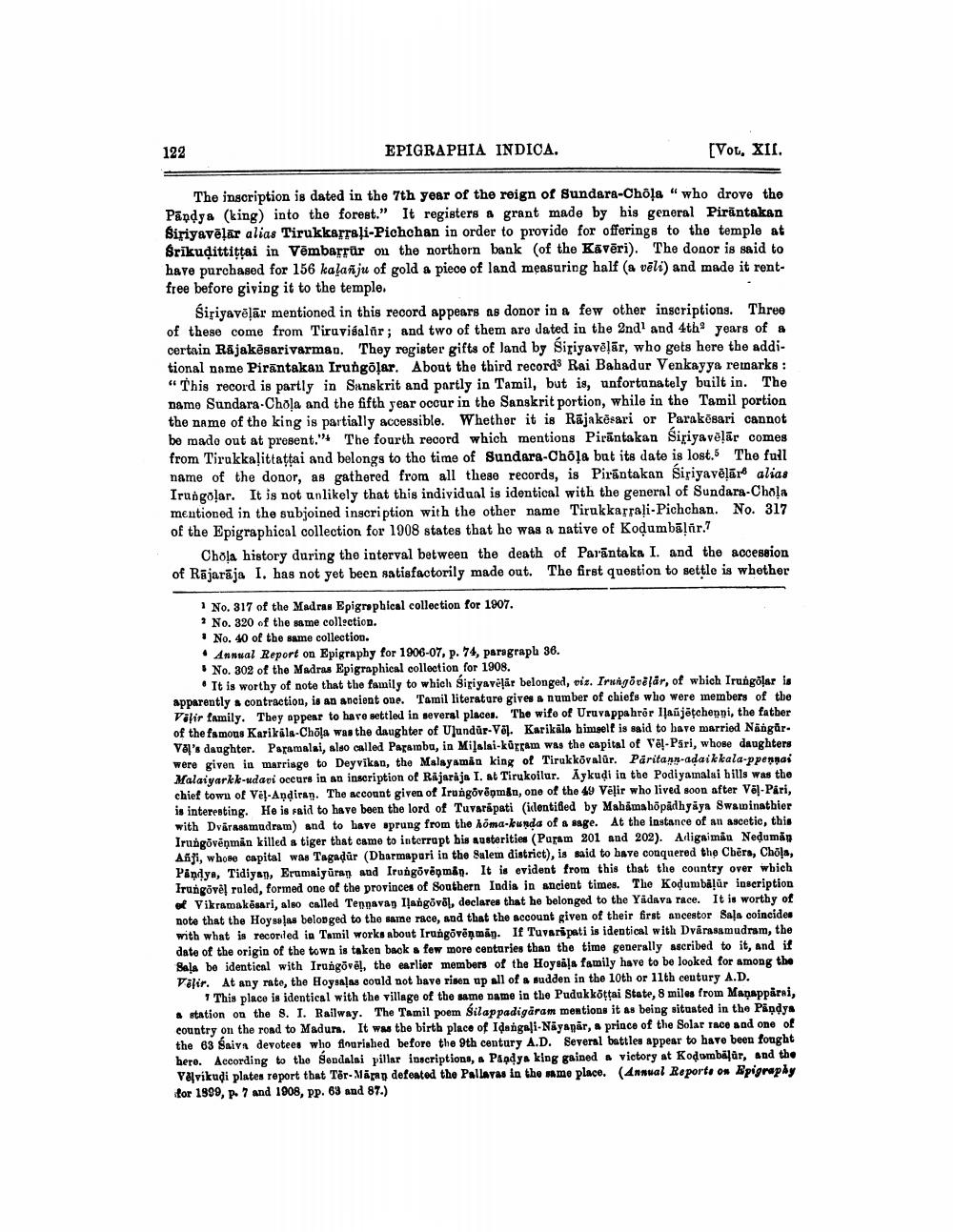________________
122
EPIGRAPHIA INDICA.
[Vol. XII.
The inscription is dated in the 7th year of the reign of Sundara-Choļa "who drove the Pandya (king) into the forest.” It registers a grant made by his general Pirintakan Siriyavēļār alias Tirukkartali-Pichchan in order to provide for offerings to the temple at Brikudittittai in Vembarrür on the northern bank of the Kávēri). The donor is said to have purchased for 156 kalasju of gold a piece of land measuring half (a vēli) and made it rentfree before giving it to the temple.
Širiyavēļār mentioned in this record appears as donor in a few other inscriptions. Three of these come from Tiruvišalar; and two of them are dated in the 2nd? and 4th years of a certain Rājakēsarivarman. They register gifts of land by Siriyavēļār, who gets here the additional name Pirāntakan Irungolar. About the third records Rai Bahadur Venkayya remarks: "This record is partly in Sanskrit and partly in Tamil, but is, unfortunately built in. The namo Sundara-Chola and the fifth year occur in the Sanskrit portion, while in the Tamil portion the name of the king is partially accessible. Whether it is Rājakēsari or Parakēsari cannot be made out at present." The fourth record which mentions Pirāntakan Siriyavēlār comes from Tirakkalittattai and belongs to the time of Sundara-Chola but its date is lost. The full name of the donor, as gathered from all these records, is Pirantakan Siriyavēļār alias Irungolar. It is not unlikely that this individual is identical with the general of Sundara-Chola mentioned in the subjoined inscription with the other name Tirukkarrali-Pichchan. No. 317 of the Epigraphical collection for 1908 states that he was a native of Kodumbālir.?
Chola history during the interval between the death of Parāntaka I. and the accession of Rājarāja I. has not yet been satisfactorily made out. The first question to settle is whether
No. 317 of the Madras Epigraphical collection for 1907. ? No. 320 of the same collection.
No. 40 of the same collection. • Annual Report on Epigraphy for 1906-07, p. 74, paragraph 36. • No. 302 of the Madras Epigraphical collection for 1908.
• It is worthy of note that the family to which Siriyavēļár belonged, vis. Irungovalar, of which Irungolaris apparently contraction, is an ancient one. Tamil literature gives a number of chiefs who were members of the Välir family. They appear to have settled in several places. The wife of Uruvappahrer lļaujëțcheggi, the father of the famous Kariküla-Chola was the daughter of Ulundür-V8]. Karikala himself is said to have married Ningår. Val's daughter. Paramalai, also called Papambu, in Milalai-karram was the capital of Vél. Pari, whose daughters were given in marriage to Deyvikan, the Malayaman king of Tirukkóvalur. Paritan-adaikkala-p pengas Malaiyarkk-udaci occurs in an inscription of Rajaraja I. at Tirukoilur. Aykudi in the Podiyamalai bills was the chiet towu of Vēļ. Andiran. The account given of Irungovēqmn, one of the 49 Vesir who lived soon after Völ-Pari, is interesting. He is said to have been the lord of Tuvarspati (ilentified by Mahimahopadhyaya Swaminathier with Dvarasamudram) and to have sprung from the homa-kunda of sage. At the instance of an ascetic, this Irungovēnman killed a tiger that came to intorrapt his austerities (Param 201 and 202). Alligaimau Neduman Anji, whose capital was Tagadur (Dharmapori in the Salem district), is said to have conquered the Chera, Chola, Pindye, Tidiyan, Erumaiyuran and Irungovēpman. It is evident from this that the country over which Irungovės ruled, formed one of the provinces of Southern India in ancient times. The Kodumbåļur inscription
Vikramakosari, also called Tennavan Ilangövől, declares that he belonged to the Yadava race. It is worthy of note that the Hoys ļas belonged to the same race, and that the account given of their first ancestor Bals coincides with what is recorded in Tamil works about Irungovēņmáy. If Tuvar pati is identical with Dvarasamudram, the date of the origin of the town is taken back a few more centuries than the time generally ascribed to it, and if Bala bo identical with Irungovől, the earlier members of the Hoysa family have to be looked for among the Välir. At any rate, the Hoysales could not bave risen up all of a sudden in the 10th or 11th ceutury A.D.
* This place is identical with the village of the same name in the Pudukkottai State, 8 miles from Manapparni, station on the s. I. Railway. The Tamil poem Silappadigaram mentions it as being situated in the Pandys country on the road to Madun. It was the birth place of Idangali-Niyapar, prince of the Solar race and one of the 63 Saiva devotees who fingrished before the 9th century A.D. Several battles appear to have been fought hero. According to the fondalai pillar inscriptions, a Padya king gained victory at Kodombafür, and the Valvikudi plates report that Tör- Märan defeated the Pallavas in the same place. (annual Reports on Epigraphy for 1999, p. 7 and 1908, pp. 69 and 87.)




